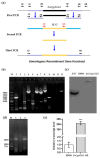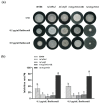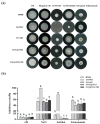The Transcription Factor CsAtf1 Negatively Regulates the Cytochrome P450 Gene CsCyp51G1 to Increase Fludioxonil Sensitivity in Colletotrichum siamense
- PMID: 36294597
- PMCID: PMC9605597
- DOI: 10.3390/jof8101032
The Transcription Factor CsAtf1 Negatively Regulates the Cytochrome P450 Gene CsCyp51G1 to Increase Fludioxonil Sensitivity in Colletotrichum siamense
Abstract
Previous studies have shown that the high-osmolarity glycerol mitogen-activated protein kinase (HOG MAPK) signaling pathway and its downstream transcription factor CsAtf1 are involved in the regulation of fludioxonil sensitivity in C. siamense. However, the downstream target genes of CsAtf1 related to the fludioxonil stress response remain unclear. Here, we performed chromatin immunoprecipitation sequencing (ChIP-Seq) and high-throughput RNA-sequencing (RNA-Seq) to identify genome-wide potential CsAtf1 target genes. A total of 3809 significantly differentially expressed genes were predicted to be directly regulated by CsAtf1, including 24 cytochrome oxidase-related genes. Among them, a cytochrome P450-encoding gene, designated CsCyp51G1, was confirmed to be a target gene, and its transcriptional expression was negatively regulated by CsAtf1, as determined using an electrophoretic mobility shift assay (EMSA), a yeast one-hybrid (Y1H) assay, and quantitative real-time PCR (qRT-PCR). Moreover, the overexpression mutant CsCYP51G1 of C. siamense exhibited increased fludioxonil tolerance, and the CsCYP51G1 deletion mutant exhibited decreased fludioxonil resistance, which revealed that CsCyp51G1 is involved in fludioxonil sensitivity regulation in C. siamense. However, the cellular ergosterol content of the mutants was not consistent with the phenotype of fludioxonil sensitivity, which indicated that CsCyp51G1 regulates fludioxonil sensitivity by affecting factors other than the ergosterol level in C. siamense. In conclusion, our data indicate that the transcription factor CsAtf1 negatively regulates the cytochrome P450 gene CsCyp51G1 to increase fludioxonil sensitivity in C. siamense.
Keywords: ChIP-Seq; Colletotrichum siamense; CsAtf1; CsCyp51G1; RNA-Seq; cytochrome P450; fludioxonil sensitivity.
Conflict of interest statement
The authors declare no conflict of interest.
Figures








Similar articles
-
CsAtf1, a bZIP transcription factor, is involved in fludioxonil sensitivity and virulence in the rubber tree anthracnose fungus Colletotrichum siamense.Fungal Genet Biol. 2022 Jan;158:103649. doi: 10.1016/j.fgb.2021.103649. Epub 2021 Dec 16. Fungal Genet Biol. 2022. PMID: 34921997
-
Overexpression of the CORVET complex alleviates the fungicidal effects of fludioxonil on the yeast Saccharomyces cerevisiae expressing hybrid histidine kinase 3.J Biol Chem. 2019 Jan 11;294(2):461-475. doi: 10.1074/jbc.RA118.004736. Epub 2018 Nov 16. J Biol Chem. 2019. PMID: 30446623 Free PMC article.
-
CgHog1 controls the adaptation to both sorbitol and fludioxonil in Colletotrichum gloeosporioides.Fungal Genet Biol. 2020 Feb;135:103289. doi: 10.1016/j.fgb.2019.103289. Epub 2019 Nov 5. Fungal Genet Biol. 2020. PMID: 31704368
-
Sensitivity of Colletotrichum fructicola and Colletotrichum siamense of Peach in China to Multiple Classes of Fungicides and Characterization of Pyraclostrobin-Resistant Isolates.Plant Dis. 2021 Nov;105(11):3459-3465. doi: 10.1094/PDIS-04-21-0693-RE. Epub 2021 Nov 16. Plant Dis. 2021. PMID: 34132595
-
Role of ChIP-seq in the discovery of transcription factor binding sites, differential gene regulation mechanism, epigenetic marks and beyond.Cell Cycle. 2014;13(18):2847-52. doi: 10.4161/15384101.2014.949201. Cell Cycle. 2014. PMID: 25486472 Free PMC article. Review.
Cited by
-
The fatty acid 2-hydroxylase CsSCS7 is a key hyphal growth factor and potential control target in Colletotrichum siamense.mBio. 2024 Feb 14;15(2):e0201523. doi: 10.1128/mbio.02015-23. Epub 2024 Jan 10. mBio. 2024. PMID: 38197633 Free PMC article.
-
What lies behind the large genome of Colletotrichum lindemuthianum.Front Fungal Biol. 2024 Oct 15;5:1459229. doi: 10.3389/ffunb.2024.1459229. eCollection 2024. Front Fungal Biol. 2024. PMID: 39473581 Free PMC article.
References
-
- O’Connell R.J., Thon M.R., Hacquard S., Amyotte S.G., Kleemann J., Torres M., Damm U., Buiate E.A., Epstein L., Alkan N., et al. Lifestyle transitions in plant pathogenic Colletotrichum fungi deciphered by genome and transcriptome analyses. Nat. Genet. 2012;44:1060–1065. doi: 10.1038/ng.2372. - DOI - PMC - PubMed
-
- Qin L.P., Zhang Y., Su Q., Chen Y.L., Nong Q., Xie L., Yu G.M., Huang S.L. First report of anthracnose of Mangifera indica caused by Colletotrichum scovillei in China. Plant Dis. 2019;103:1043. doi: 10.1094/PDIS-11-18-1980-PDN. - DOI
-
- Huang R., Sun W., Wang L., Li Q., Huang S., Tang L., Guo T., Mo J., Hsiang T. Identification and characterization of Colletotrichum species associated with anthracnose disease of banana. Plant Pathol. 2021;70:1827–1837. doi: 10.1111/ppa.13426. - DOI
Grants and funding
LinkOut - more resources
Full Text Sources

